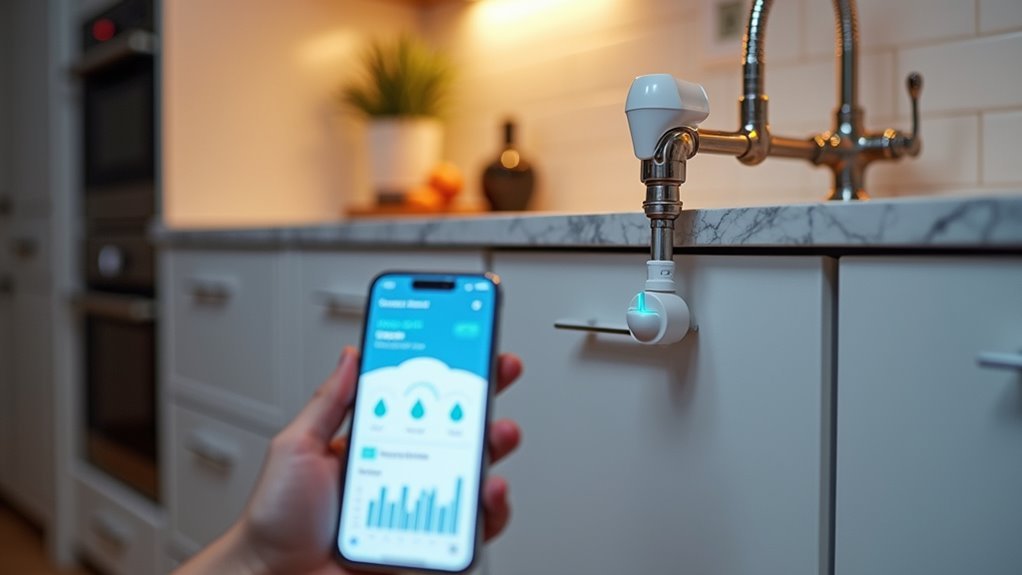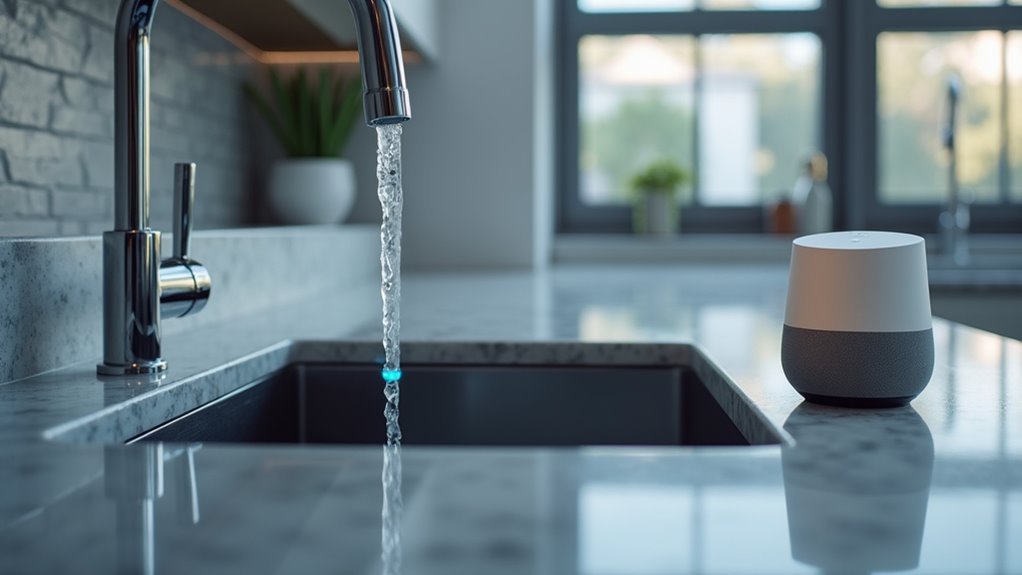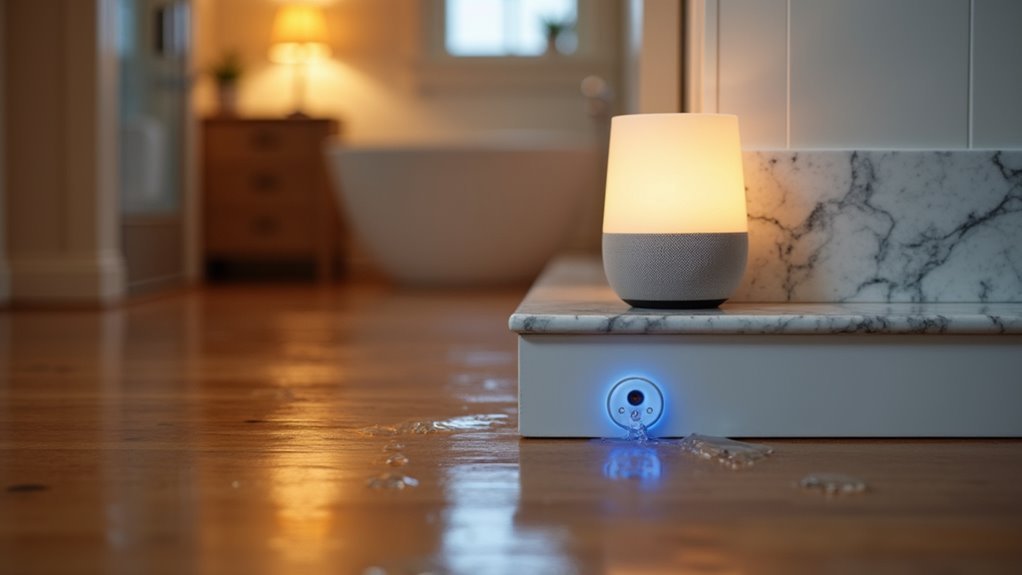You’re probably checking your basement for water leaks the old-fashioned way – walking downstairs with a flashlight, hoping you won’t find an unpleasant surprise. But what if your home could simply tell you about water problems the moment they start? Voice-controlled leak detection transforms your smart speakers into vigilant guardians that monitor every drop. The technology’s capabilities extend far beyond basic alerts, offering features that could completely change how you protect your property.
How Voice Commands Transform Water Monitoring

Within seconds of a water leak starting in your home, voice-controlled smart detectors can alert you through your Amazon Alexa or Google Assistant device.
Your smart water monitor transforms traditional leak detection by enabling hands-free interaction with your water management system. You’ll receive real-time updates about water usage simply by asking your voice assistant for status reports.
This voice control integration allows you to check consumption statistics without reaching for your smartphone.
When your smart home system detects unusual water flow patterns, you’ll get immediate notifications through your preferred voice platform.
The seamless connectivity between your leak detection technology and voice assistants creates a proactive monitoring experience, helping you address potential water issues before they become costly problems.
Compatible Voice Assistants for Smart Water Systems
Which voice assistants work best with your smart water detection system? Your water leak detectors can integrate seamlessly with popular voice control platforms, transforming how you monitor your home’s water usage.
| Voice Assistant | Compatible Devices | Key Features |
|---|---|---|
| Amazon Alexa | Flume 2, Flo by Moen | Usage queries, leak alerts |
| Google Assistant | Select smart devices | Water monitoring, notifications |
| IFTTT Integration | Multiple systems | Custom commands, automation |
Amazon Alexa leads compatibility with most water leak detectors, letting you ask about usage patterns or receive hands-free alerts. Google Assistant offers similar functionality with select smart devices. IFTTT integration expands your options by connecting various systems through custom voice commands. You’ll enjoy the convenience of monitoring water usage without accessing apps directly, while voice-activated shutoff features provide extra protection against costly leaks.
Setting up Alexa With Your Water Leak Detector

Setting up your water leak detector with Alexa requires just a few straightforward steps that’ll have you monitoring water usage through voice commands in minutes.
First, verify your water leak detector model supports Alexa integration—devices like the Flume 2 offer excellent voice control compatibility. Download your detector’s app and complete the initial setup by connecting it to your Wi-Fi network.
Next, open the Alexa app and navigate to Skills & Games. Search for your specific water leak detector’s skill and enable it by linking your device account.
Once connected, you can use voice commands like “Alexa, ask [device name] for the water usage report” to receive real-time updates.
Ensure your Alexa device maintains strong Wi-Fi connectivity for peak performance and reliable voice command response.
Google Assistant Integration for Water Management
Beyond Alexa compatibility, Google Assistant integration transforms your water leak detection system into a thorough voice-controlled monitoring hub that responds to natural language commands.
Your smart water leak detector becomes instantly accessible through simple voice requests, allowing you to check real-time usage statistics and receive immediate water leak alerts without touching your phone.
Google Assistant’s voice control capabilities offer several advantages:
- Hands-free monitoring for users with mobility challenges or busy schedules
- Custom alert setup to stay informed about consumption patterns and potential issues
- Smart home automation that integrates water management into existing routines alongside other connected devices
You’ll monitor your home’s water systems effortlessly by asking Google Assistant for status updates, creating a seamless experience that keeps you informed about leaks and usage patterns.
Voice Commands for Real-Time Water Usage Monitoring

How quickly can you access critical water usage data when you’re cooking dinner or your hands are covered in garden soil? Voice control transforms your smart home water monitoring into an effortless experience. Smart water leak detectors like Flume 2 integrate seamlessly with voice assistants, letting you check consumption levels hands-free.
You’ll receive instant updates about unusual water usage patterns through custom voice commands. Simply ask your device about current flow rates or request detailed consumption reports to identify trends.
| Command Type | Example Voice Prompt | Response Information |
|---|---|---|
| Current Usage | “Alexa, check water usage” | Real-time flow data |
| Alert Status | “Hey Google, water leak alerts?” | Active notifications |
| Daily Reports | “Show today’s water consumption” | Usage summaries |
| Threshold Settings | “Set water usage alert at 50 gallons” | Custom notifications |
This integration streamlines monitoring while enhancing your proactive water management capabilities throughout your home.
Hands-Free Leak Alert Management
When a water leak strikes at 3 AM, you don’t want to fumble with smartphone apps or squint at tiny screens. Smart leak detectors with voice control capabilities let you manage critical alerts hands-free, even in the dark.
Voice-controlled leak detectors eliminate the hassle of fumbling with devices during middle-of-the-night water emergencies.
Simply speak to your voice assistant to get immediate updates about your water system’s status and take swift action when needed.
Voice-controlled leak management offers several practical advantages:
- Instant status updates – Ask your assistant about current water usage and leak detection without touching any device
- Quick setting adjustments – Modify alert preferences or sensitivity levels through simple voice commands
- Emergency response – Receive immediate notifications and instructions during water emergencies
This hands-free approach eliminates delays in emergency response, ensuring you can address leaks quickly and protect your home from costly water damage.
Smart Water Shutoff Control Through Voice
Voice alerts become even more powerful when you can instantly shut off your home’s water supply through the same voice commands.
Smart water shutoff devices like Flo by Moen integrate seamlessly with Amazon Alexa and Google Assistant, letting you control your water system hands-free. Simply say “Alexa, turn off the water” to prevent flooding when leak detection alerts trigger.
Your mobile app provides real-time monitoring and control options, allowing you to manage shutoff settings remotely. You can create custom voice commands to check water usage statistics or enable automatic shutoff features.
While professional installation is required, these systems deliver significant long-term savings by preventing costly water damage repairs.
IFTTT compatibility enables advanced automation recipes for thorough water management.
Voice-Activated Water Pressure and Temperature Checks
Why settle for guessing your home’s water conditions when you can instantly check pressure and temperature through voice commands?
Voice-activated water pressure and temperature checks transform your water leak detector into a thorough monitoring system. You’ll receive real-time updates on water pressure measured in psi, with alerts when levels exceed the safe residential range of 60-80 psi.
Your system monitors these critical conditions:
- Water pressure readings that prevent plumbing damage from excessive force
- Ambient temperature monitoring with freeze alerts below 32°F
- Water flow rate measurements in gallons per minute to detect irregularities
Smart home systems integration lets you customize alert thresholds and receive voice notifications when conditions fall outside safe parameters.
Simply ask your device about current water conditions and get instant, actionable information.
Creating Custom Voice Routines for Water Safety
Since water emergencies require immediate action, creating custom voice routines transforms your leak detection system into a proactive safety network that responds automatically to threats. Your smart assistant can execute complex water leak detection protocols through voice control, delivering real-time alerts when problems arise.
| Routine Type | Voice Command | Automated Response |
|---|---|---|
| Leak Alert | “Alexa, water emergency” | Notify all household members |
| Budget Monitor | “Hey Google, water usage” | Report daily consumption levels |
| Mode Switch | “Alexa, leaving home” | Activate away monitoring mode |
| Area Check | “Hey Google, basement check” | Remind to inspect leak-prone zones |
| System Status | “Alexa, water system” | Provide thorough detector overview |
Custom voice routines enhance accessibility while ensuring extensive water safety monitoring throughout your home.
Troubleshooting Voice Control Connectivity Issues
When your smart water leak detector won’t respond to voice commands, you’re likely dealing with Wi-Fi connection problems, voice assistant setup issues, or app sync failures.
These connectivity hiccups can prevent your device from communicating properly with Alexa or Google Assistant, leaving you without hands-free control of your water safety system.
Let’s tackle the most common problems and get your voice control back online quickly.
Wi-Fi Connection Problems
Three common Wi-Fi issues can disrupt your smart water leak detector’s voice control functionality.
Connectivity problems often stem from network compatibility, signal strength, or device configuration issues that require systematic troubleshooting.
Start by ensuring your water leak detector connects to a 2.4 GHz Wi-Fi network, as many devices don’t support 5 GHz connections.
Check that your network signal is stable and within range, since weak signals cause disruptions.
- Restart both your router and water leak detector to resolve temporary connectivity glitches
- Update your device’s firmware through the app to fix bugs affecting Wi-Fi performance
- Consult your installation guide or contact customer support for model-specific troubleshooting steps
These targeted solutions will restore reliable connectivity and get your voice control features working properly again.
Voice Assistant Setup
Successful voice assistant integration requires your water leak detector to communicate properly with Amazon Alexa or Google Assistant through a series of specific setup steps.
First, verify your device’s compatibility with your chosen voice assistant platform. Connect your water leak detector to a stable Wi-Fi network, ensuring it uses the required 2.4 GHz frequency for peak performance. Download the manufacturer’s app and link it to your voice assistant following the provided instructions.
If you encounter connectivity issues, update your app to the latest version and configure your voice assistant correctly to recognize device commands.
Check that permissions are properly set, allowing both the app and voice assistant access to necessary features. When voice commands fail, reboot both devices to reset temporary connectivity glitches.
App Sync Failures
Although voice assistant connectivity depends on seamless app synchronization, you’ll frequently encounter sync failures that prevent your water leak detector from responding to voice commands.
These connectivity issues typically stem from incompatible software or network problems that disrupt communication between your smartphone and the detection system.
To resolve app sync failures effectively:
- Check compatibility requirements – Confirm your smartphone runs iOS 11+ or Android 6+ for ideal performance
- Verify Wi-Fi network settings – Confirm your 2.4 GHz network is stable and within range of the device
- Restart both systems – Refresh your smartphone and app to eliminate temporary glitches
When sync problems persist, verify your Flume device installation and calibration.
Proper setup guarantees reliable real-time alerts and seamless voice control functionality for thorough water leak protection.
Voice Control Privacy and Security Considerations
When you’re setting up voice-controlled water leak detection systems, you’ll need to understand how your data gets protected through encryption standards that safeguard your personal information in the cloud.
Your voice commands typically require authentication methods like two-factor verification to prevent unauthorized users from accessing your system.
You should also review what third-party access controls are in place, since manufacturers may share usage data with affiliates unless you opt out of these arrangements.
Data Encryption Standards
Since voice-controlled smart water leak detectors process and transmit sensitive household data, manufacturers implement robust encryption standards to safeguard your personal information.
Your user data gets encrypted in the cloud, preventing unauthorized access to your personal details and usage patterns.
These devices protect your privacy through multiple security layers:
- Account Protection: Username and password requirements guarantee only authorized users access your device controls and alerts
- Enhanced Authentication: Two-factor authentication during setup adds an extra security barrier to your account
- Data Control: You can opt-out of sharing personal and usage data by submitting email requests, giving you control over your privacy settings
Smart water leak detectors typically don’t sell your personal information, though they may share aggregated usage data with affiliates while maintaining transparency about their data encryption practices.
Voice Command Authentication
Voice command authentication adds a personalized security layer by recognizing your unique vocal patterns and requiring specific phrases to access critical functions. When you set up smart water leak detectors with voice control, you’ll typically encounter two-factor authentication protocols that verify your identity through multiple channels. This enhanced user privacy protection makes unauthorized access considerably more challenging for potential intruders.
| Authentication Feature | Privacy Benefit |
|---|---|
| Unique voice patterns | Personalized access control |
| Specific command phrases | Prevents accidental activation |
| Two-factor verification | Enhanced account security |
| Data encryption protocols | Protected transmission |
Your voice commands work alongside robust data encryption systems that safeguard transmitted information in the cloud. You’ll have opt-out options available if you prefer limiting data sharing with third-party affiliates, giving you greater control over your personal information.
Third-Party Access Controls
Three key areas demand your attention when managing third-party access to your voice-controlled water leak detection system.
Your Wi-Fi water leak detector requires careful oversight to protect your personal information while maintaining functionality.
Start by thoroughly reviewing privacy policies before connecting your device to voice assistants.
These documents reveal how manufacturers handle user data, including whether they’ll share your information with affiliates or third parties.
Essential security measures include:
- Implementing two-factor authentication during device setup to prevent unauthorized access
- Enabling opt-out options for data sharing when available
- Installing regular firmware updates to patch security vulnerabilities
Your user data gets encrypted and stored in cloud servers, but you’re responsible for managing access permissions.
Stay proactive about monitoring which third-party services can interact with your system and revoke unnecessary permissions regularly.
Smart Home Hub Requirements for Voice Integration
When integrating water leak detectors with voice assistants, you’ll need to contemplate whether your chosen device requires a dedicated smart home hub. Many detectors, like the YoLink Water Leak Sensor, can’t achieve voice control without purchasing additional hub hardware, increasing your overall costs.
However, compatibility varies greatly between brands and platforms. Some devices offer direct integration paths that bypass hub requirements entirely. The Eve Water Guard connects directly with Apple HomeKit, enabling seamless Siri voice control without extra equipment.
Meanwhile, the Flume2 Smart Home Water Monitor supports Amazon Alexa integration for checking water usage through voice commands.
Your existing smart home ecosystem matters too. If you’re already using SmartThings or Google Home hubs, verify your water leak detectors support these platforms for streamlined integration and ideal voice control functionality.
Advanced Voice Features for Whole-House Water Systems
Beyond basic voice commands for individual leak detectors, extensive whole-house water monitoring systems reveal sophisticated voice-activated features that transform how you manage your entire water infrastructure.
These advanced voice control capabilities enable thorough oversight of your property’s water leak detection network through natural conversation with your smart home systems.
You’ll access powerful features including:
- Thorough water budgeting – Set monthly usage limits and receive real-time alerts when approaching thresholds
- Zone-specific monitoring – Query individual areas like “Alexa, check basement water status” for targeted leak detection
- Emergency automation – Trigger automated responses that immediately shut off main water supply during critical leak events
Voice integration guarantees you’re constantly connected to your water infrastructure, enabling instant decision-making that prevents costly damage while maintaining ideal household water management.
Future Developments in Voice-Controlled Water Technology
As voice-controlled water technology continues evolving, you’ll witness groundbreaking innovations that’ll revolutionize how smart home ecosystems detect and respond to water emergencies. Enhanced leak detection systems will integrate seamlessly with Amazon Alexa and Google Assistant, enabling instant automated shutoff through voice commands during critical situations.
| Feature | Current Capability | Future Development |
|---|---|---|
| Voice Commands | Basic on/off controls | Emergency shutoff activation |
| Leak Detection | Standard sensors | Machine learning algorithms |
| Smart Home Integration | Limited connectivity | Zigbee/Z-Wave protocols |
| User Interaction | Generic alerts | Personalized voice notifications |
Machine learning algorithms will analyze your historical water usage patterns, providing real-time recommendations through voice interactions. Advanced connectivity options will facilitate complex automated workflows, while personalized voice recognition technology will deliver tailored alerts about potential leaks and water consumption patterns.
Frequently Asked Questions
Do Water Leak Detectors Really Work?
Yes, water leak detectors work effectively. You’ll get real-time alerts within two seconds of detection, save 10-20% on water bills, and prevent costly damage through accurate monitoring that identifies leaks as small as 0.25 gallons per minute.
Is There an App That Detects Water Leaks?
Yes, you’ll find several apps that detect water leaks. Smart detectors like Flume2, Flo by Moen, and Govee offer dedicated mobile apps providing real-time alerts, usage insights, and remote monitoring capabilities for your smartphone.
How Much Does It Cost to Install a Water Leak Detection System?
You’ll spend $20-$500+ for water leak detection systems, depending on features. Basic sensors cost $20-$100, while extensive systems with automatic shutoff reach $500+. Professional installation adds another $250+ to your total investment.
Where Should Water Leak Sensors Be Placed in a House?
You should place water leak sensors near high-risk areas like kitchens, bathrooms, and basements. Install them close to appliances such as dishwashers, washing machines, water heaters, and sump pumps for early detection.





Leave a Reply